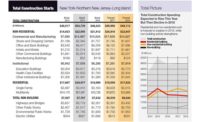ENR New York’s Top Starts list includes the 60 largest regional projects to break ground in 2019, compiled mostly from Dodge Analytics data. For ease of comparison, the total project cost of the 40 highest-ranking projects was $16.22 billion. That’s an 11.5% increase from the $14.5-billion total for the top 40 starts in 2018.
The 11 transportation projects on the list totaled $1.84 billion. Highlights include improvements to heavily used roadways in Jersey City, N.J., worth $97 million. Mixed-use buildings accounted for 10 jobs worth $1.4 billion. One notable project, Phase Two of the Liberty Harbor North One Park Vantage Mixed-Use Complex, was valued at $160 million. The project, also in Jersey City, will rise 448 ft and consist of 452 residential units, 7,000 sq ft of retail space and more than 100 parking spaces.
Also in New Jersey, the $86.5-million Gateway Expansion natural gas pipeline project aims to meet the state’s increased energy demand.
|
Related Link |
Residential developments include the highest-ranking project on the list, the Hunters Point South Phase 2 Parcel C (North Tower) in Long Island City, Queens, expected to cost $500 million. The 1.4 million sq ft of residential and retail space will include 1,400 apartments.
Additionally, the list ranks five warehouses together worth $612 million. Highlights in the category include what’s being touted as a record-size two-story fulfilment center, located in the Bronx. The $260-million project aims to bring same-day delivery to e-commerce shoppers in the New York metro market.
In September 2019, Amazon started its own 1-million-sq-ft fulfilment center in Shodack, N.Y., worth $100 million. It will become the company’s first large-scale distribution center in upstate New York.
Education projects on the list include the $107-million Phase 2 of the Greece Central School Capital Improvement Project in Rochester, N.Y., and a Camden, N.J., high school worth $99.59 million. Notable university projects include the $90-million, 1,200-bed North Campus freshman dormitory at Cornell University in Ithaca, N.Y., and a $118-million renovation of the Carrier Dome’s iconic air-supported roof at Syracuse University in Syracuse, N.Y., which fits within a 20-year plan for developing the physical campus.
Two projects from the NYC School Construction Authority—ENR New York’s Owner of the Year—also are on the list: Staten Island’s $78.12-million New Hungerford School, also called IS/HS 86R Intermediate & High School, and Intermediate School 419 in Flushing, Queens, worth $68 million.
Three projects in the technology, medical/pharmaceutical and research sectors totaled $375 million—notable because, as ENR previously reported (ENR New York 7/16/18 p. NY6), scientific laboratories and offices are a big opportunity for the region. The Life Sci NYC initiative in 2018 set aside $300 million for tax abatements when a developer builds life science spaces and another $100 million in capital spending for an innovation hub.
Regeneron Pharmaceuticals Inc.’s $188-million Regeneron Manufacturing Facility in East Bush, N.Y., will include a two-story, 346,000-sq-ft structural steel frame building. A life sciences facility conversion from a former warehouse in Long Island City, worth $67 million, includes a six-story, 91,210-sq-ft building with reinforced concrete that includes laboratory and office spaces.
“Be creative and do something different nobody’s ever heard of.”
– Joshua Wein, Managing Director of Finance, RAL Cos.
These projects, along with Zero Irving—also called the Union Square Tech Hub and worth $200 million, including a $120 million loan—contribute to hopes that New York and New Jersey will become a tech and life sciences hub. Joshua Wein, managing director of finance at RAL Cos., the developer of Zero Irving, says he believes spaces for tech companies and R&D centers will become a bigger construction trend for the region.
“This RFP became one of several responding to New York City seeing the need to promote 21st-century jobs,” Wein says. “We’ll likely see a lot more like this one.”
The tech hub at 124 E. 14th St., a nearly 237,900-sq-ft, 21-story reinforced concrete building, will yield affordable and market-rate office space for tech firms. It will also offer space for retail and for dining facilities managed by Urbanspace. Civic Hall, a collaborative work and event space, will anchor the center.
Wein says the development is designed to give back to New York and inspire tech entrepreneurship. Partnerships with Civic Hall and the New York City Economic Development Corp. allow the Union Square Tech Hub to dedicate three floors to digital skills training. “We’ll see collaborative spaces licensed out for training to organizations at rents and shorter leases they can afford. Any for-profit organization renting the space must offer either free education or scholarships,” Wein says. “We’ve not seen this before.”
He points to architectural details of the building, which include elevated ceiling heights. Tenants can use the area as a collaboration space. Wein says he’s most proud of the exterior view with its all-glass double height spaces and wide column spacing.
Builders of tech centers in New York City must deal with constrained sites as well as issues related to renovating and repurposing old buildings.
The project team on Zero Irving, which has LEED Gold certification and a WiredScore platinum rating, also overcame special challenges to install the right level of “connectivity” for high-tech spaces, Wein says.
The site is sandwiched between two large buildings, with the L-train running parallel. Because the subway runs down the roadbed, existing infrastructure is sandwiched between the train tunnel and the building lines, creating “a complex web” of infrastructure “knowns and unknowns,” which required “a great deal of exploratory work throughout the entire connectivity process,” he says.
While conversions remain RAL’s bread and butter, Wein sees more tech hubs and increased commercial development in its future. “Be creative and do something different nobody’s heard of,” he encourages other developers. “And if you’re building tech hubs, ensure you’re giving back to the tech community.”





Post a comment to this article
Report Abusive Comment